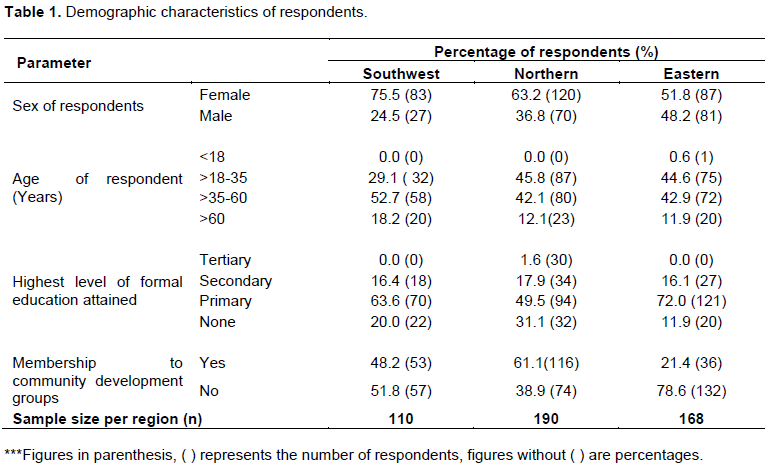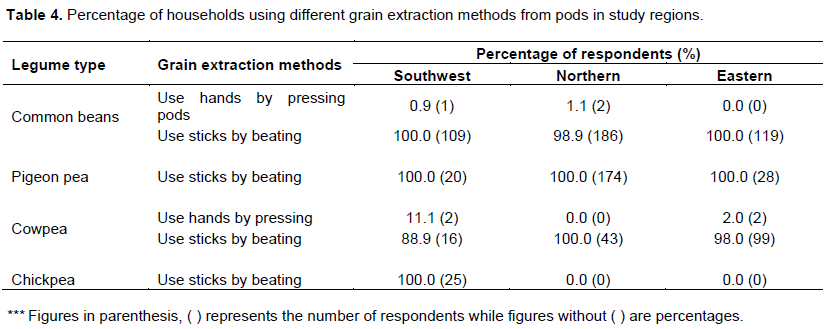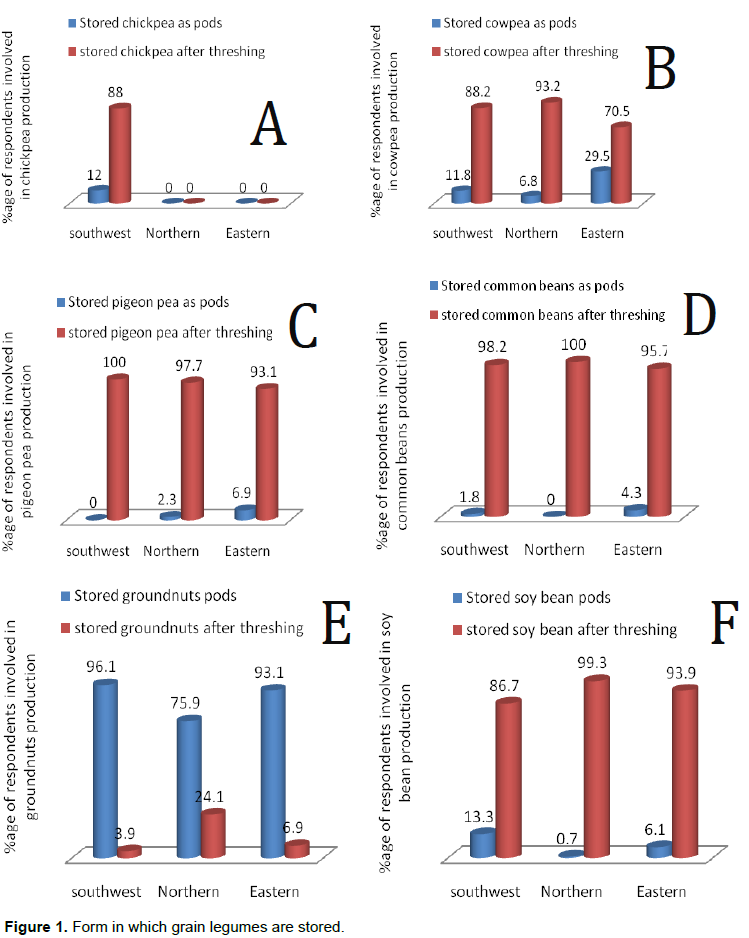ABSTRACT
Cowpea (Vigna unguiculata), Chickpea (Cicer arietinum) and Pigeon pea (Cajanus cajan) are among important food legumes in African small scale agricultural systems and livelihoods of many rural poor. High volumes of these food legumes are lost during storage, mostly to a group of beetles called bruchids. To be able to develop safe, sustainable and effective practices of managing storage bruchids, it was critical to first understand farmers’ indigenous innovations of handling food legumes in the selected regions. A household survey was conducted to determine the various indigenous innovations used in postharvest handling of food legumes in purposively selected areas in South-western, Northern, and Eastern regions of Uganda. A total of 468 households were covered and data was collected using a pretested semi-structured questionnaire focusing on major postharvest handling innovations. Results indicated that there were differences in terms of innovations used by farmers in postharvest handling of food legumes across the three study regions. Results also revealed that the targeted legumes were mostly dried on bare ground whereas in other cases were left to dry in the fields. Over 63% of households in Northern region used synthetic pesticides to manage bruchids whereas over 80 and 58% in South-western and Eastern regions used indigenous innovations respectively. The indigenous innovations identified for bruchids management were; wood ash, cowdung ash, goat pellets, pesticidal plants, airtight created conditions, and frequent sun drying of grains. Other innovations reported included use of finely crushed burnt bricks. There was no standard procedure during the use of indigenous innovations among households to achieve consistent protection of storage legume grains against bruchids. The study suggests the need for sustainable and easily adaptable innovations for improved postharvest handling of not only targeted grain legumes but also other food legumes under smallholder farming systems in Uganda.
Key words: Bruchids, innovations, grain legumes, food, nutrition.
Food legume crops also referred to as pulses are important low cost sources of dietary proteins for millions of rural poor in developing countries especially in Sub-Saharan Africa. Cowpea (Vigna unguiculata), Chickpea (Cicer arietinum) and Pigeon pea (Cajanus cajan) are among the food legumes that occupy an important place in food and nutrition of the people in tropics (Abate et al., 2012). In Africa, these three legumes are cultivated on over 13 million hectares (ha) in 2014 of which 90% is under cowpea production, 5.0% chickpea and 5.0% pigeon pea (FAOSTAT, 2016). They represent an important component of agricultural food crops consumed and are considered vital crops for achieving food and nutritional security. These leguminous crops are important in resource poor smallholder farming systems due to their high drought tolerance compared to other food legumes (Barrera-Figueroa et al., 2011; Temu et al., 2014). To harness the benefits of cowpea, chickpea and pigeon pea, Mbarara Zonal Agricultural Research and Development Institute (MBAZARDI) and its partners have been promoting their production and utilization to alleviate protein and micronutrient deficiency among banana dominated farming communities in south western Uganda (http://www.ccrp.org/node/380). The seasonality of these crops negatively impacts on the all year round household demand. Thus proper processing and storage would play a big role in bridging the gap between production seasons. Unfortunately, high grain volumes are lost during postharvest handling. At farm level postharvest losses occur at different stages of crop handling (that is, harvesting, drying, threshing, winnowing, storage, transportation, packaging and marketing). However, highest postharvest losses in legumes usually occur at storage stage. Postharvest losses result in loss of market opportunities and nutritional value of legume grains (Damte and Dawd, 2006). At storage stage, the losses are especially due to a group of beetles called bruchids (Temu et al., 2014). Three genera of bruchids Acanthoscelides, Zabrotes and Callosobruchus are the most important insect pests on most stored food legumes in Africa causing losses of up to 100% (Abate et al., 2000). Species from Callosobruchus genus especially C. chinensis (L) and C. maculatus (L) are the most important storage insect pests of cowpea, chickpea and pigeon pea in East Africa (Sanon et al., 2010). Acanthoscelides obtectus, Say and Zabrotes subfaciatus are considered secondary storage insect pests of these legumes (CABI, 2013).
In South-western Uganda immense bruchid damage inflicted on these grain legumes had derailed farmers’ efforts to increase production and utilization of cowpea, chickpea and pigeon pea. This has continued to threaten food, nutrition and income security, thus aggravating hunger and poverty among smallscale farmer households. Storage pest problem especially bruchids is more pronounced as most farmers have not fully integrated synthetic pesticides into their insect pest management systems due to subsistence nature of production and high poverty levels. This causes farmers to rely on indigenous innovations to meet their pest management needs. Indigenous innovations used in management of storage pests particularly bruchids are myriad, diverse and usually location and geographical specific (Mihale et al., 2009). The aim of this study was to identify and document farmers’ indigenous innovations for processing and storage of selected food legumes in Uganda.
Study area
A household survey to determine various indigenous innovations used in primary processing, storage and management of storage bruchids of targeted legumes was carried out in selected areas of South-western (Isingiro District), Northern (Lira and Pader Districts), and Eastern (Kaberamaido and Soroti Districts).
Sampling procedure, data collection and analysis
In northern and eastern regions of Uganda, different distinct communities inhabit different districts. Data was gathered from Acholi and langi communities as well as Itesot and Kumam communities in northern and Eastern regions of Uganda respectively. In each district, four parishes were purposively selected with the help of agricultural production staff either at the district and or sub county basing on where targeted legumes (cowpeas, pigeon peas and chickpeas) are highly cultivated. Sampling of households involved in production of targeted legumes was purposively selected with the help of community leaders at parish level. In each parish selected, data was collected using a pretested semi-structured questionnaire administered by trained personnel. A total of 468 households were reached during the study of which 110 households were in South-western region, 190 households in Northern region and 168 in Eastern region. Data collected was coded, cleaned and analyzed using SPSS software version 20. Frequency tables including cross-tabulations were generated.
Demographic characteristics of respondents
In all the sampled regions, majority of the respondents (on average 63.5%) were female respondents (Table 1). Majority of the respondents (86.4%) were aged between 18 to 60 years representing the most active group in the society. The biggest proportion of respondents reached across the sampled regions had at least attained primary level of formal education (Table 1). In Eastern region, majority of respondents (78.6%) were not in organized groups unlike in northern region where a large proportion (61.1%) of respondents were organized into community development groups.
Status of legume crops production in study areas
Common beans (Phaseolus vulgaris) and groundnuts (Arachis hypogea) were the most dominant legume crops grown across all the sampled regions. Pigeon pea (Cajanus cajan) and cowpea (Vigna unguiculata) production dominated in Northern and Eastern regions respectively. Chickpea (Cicer arietinum) and field pea (Pisum sativum) production were localized to Southwestern Uganda where some few respondents were also growing pigeon pea and cowpea. Soybean (Glycine max) production dominated in northern region compared to other studied regions mainly due to economic value attached to it in this region. Green gram (Vigna radiata) was mainly grown in Eastern region with few respondents engaged in its production in Northern Uganda (Table 2). The dominating status of different legumes in the respective regions is in line with what was earlier reported by Nedumaran et al. (2015) that noted the great importance of grain legumes in developing countries. Overall, not all the 468 respondents were involved in the production of each of the reported legumes and thus the analysis of each of the above legumes will be based on the respective subsets of respondents (Table 2).

Among respondents who were involved in bean, cowpea, green gram, groundnuts, soybean, and pigeon pea production in both northern and eastern regions, the majority were handling between 100 to 500 kg after harvest. In South-western Uganda those involved in production of cowpea, pigeon pea, chickpea, soybean and field pea were handling quantities of less than 50 Kg. Generally, the eight grain legumes were grown at subsistence scale though a limited number of households were handling substantial quantities of over 500 Kg of grains (Table 5). The results are consistent with the nature of smallscale farming systems in Uganda (UBOS, 2014). It was also noted that chickpea volumes handled after harvest was low and its production was localized in South-western region. This is probably due to chickpea being highly susceptible to field biotic stresses especially American bollworm ((Helicoverpa armigera (Lep: Noctuidae)) and Ascochyta blight (Ascochyta rabiei). In addition, the low production of chickpea can be associated to the crop being newly introduced in the country. The results suggest the need to develop innovations for sustainable management of the production challenges of chickpea and also changing the mindset for socioeconomic transformation from peasantry agriculture to commercial farming.
Drying of legume crop harvest
Across the three sampled regions it was noted that households dry legume grains using different methods to attain low moisture content. In Northern and Eastern regions, almost all of households dry all their legume crop harvests on the bare ground (Table 3). Majority of the households were also drying groundnuts on bare ground (data not shown). This method of drying predisposes the grains further to mould contamination which leads to mycotoxin production in the grains. Kaaya (2004) noted that traditional drying techniques in Uganda involving bare ground drying are a major source of fungal contamination in groundnuts. Drying of legume grains on the bare ground thus pose a public health concern to consumers of legume grains. Ingestion of mycotoxins may cause mycotoxicosis which can result in either an acute or chronic disease episode. Some mycotoxins are carcinogenic, mutagenic, teratogenic, estrogenic, hemorrhagic, immunotoxic, nephrotoxic, hepatotoxic, dermotoxic and neurotoxic (Waliyar et al., 2015). It was observed that some households in South-western region of Uganda were drying their legume harvests on tarpaulin. Similarly a higher proportion of households in Northern region than in Eastern region were using tarpaulins for primary processing of their harvests. This was probably due to differential efforts of belonging to organized community development groups as well as contribution of post-civil war rehabilitation institutions such as non-governmental organizations in the region. The major reason indicated for using tarpaulins was to avoid accumulation of sand particles in the produce that would make it laborious during grain sorting when needed for either sale or and food. Notably a reasonable proportion of households were leaving their legume crops to dry in the field and this may increase the chances of storing bruchids infested grains. This exacerbates the challenge of mycotoxins in the stored grains as the activities of the bruchids create conditions that favour the fungal growth. To this end, traditional drying practices observed in the study regions in Uganda need to be improved for household food security.
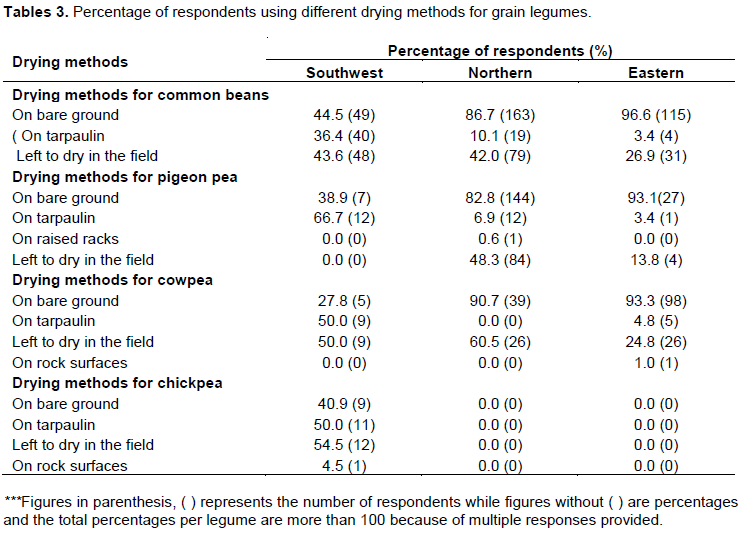
Extracting legume grains from pods
Majority of households in all the three regions thresh the studied legumes using sticks by beating (Table 4). Majority of respondents reported that using sticks to thresh legume grains is a time saving method. However, some respondents indicated the drawback of the method in inflicting damage on the grains. The resultant damaged grains become more susceptible to mould contamination, hence, affecting the food safety of grains to humans and domesticated animals.
Storage facilities and storage of legume grains
Majority of the households in all the study regions stored grain legumes in their living houses mainly in polyvinylchloride (PVC) bags. However, a limited number of households stored their grains in traditional granaries. Apart from groundnuts, majority of households stored grain legumes after threshing (Figure 1A to F). Household respondents indicated that storing threshed grain legumes was convenient in terms of reducing bulkiness of stored crop. Due to high susceptibility of chickpea to bruchids infestation, households preferred to store it in pods rather than in threshed form.
Bruchids management options
The results revealed a range of bruchids management options across the study regions (Table 6). In South Western and Eastern regions, majority of households (81.5 and 58.9% respectively) used local options to protect their legume grains against bruchids infestation. On contrary, in Northern region, majority of households (63.1%) used synthetic pesticides (malathion dust or Aluminium phosphide pellets) to control bruchids. Although use of synthetic pesticides was reported to be very effective in controlling bruchids in grains, they pose a great health and environmental risk. In all the study regions, a small proportion of the households alternated between synthetic and local options to control bruchids in stored legume grains. The choice of options was determined by the availability of financial resources in the households. Among the local options used, pesticidal plants dominated in Eastern and Northern regions whereas cowdung ash was the mostly used option in South-western region in controlling bruchids. This implied that there is need to evaluate a range of options in each region so that farmers can select what fits them. Among pesticidal plants, hot pepper (Capsicum fruitensis L) was mostly used in Northern and Eastern regions whereas in South-western region, Cupressus lusitanica L was the most pesticidal plant used. Lantana camara L was widely used in Eastern region as a legume grain protectant against bruchids. Our findings collaborate with Mihale et al. (2009) who noted diverse indigenous pest management innovations.
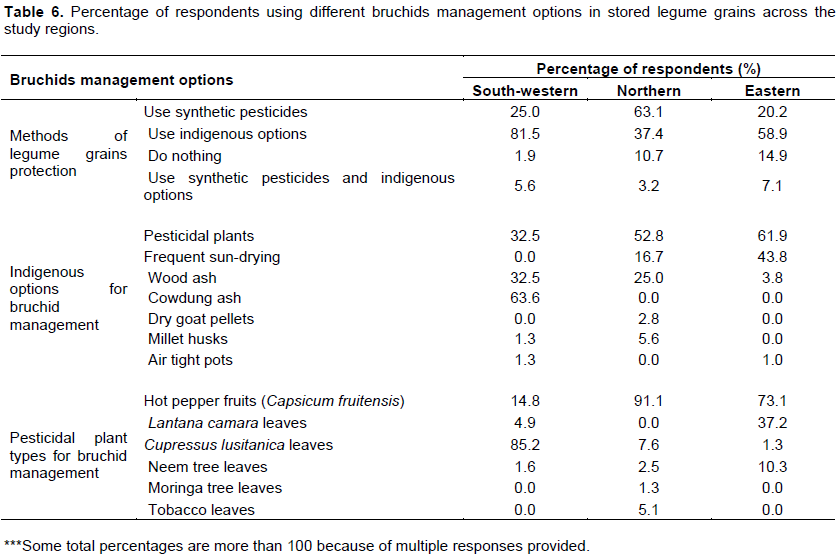
The importance of legume crops in the livelihood of Ugandans cannot be overemphasized. This study noted key concerns in grain legumes postharvest handling practices that pose great threat to safety and loss of food especially practices that predispose the grains to mycotoxin contamination as well as bruchids infestation. Numerous indigenous innovations for management of bruchids in stored grains were noted in Uganda, however, there is limited information on food safety risks associated with them as well as lack of standard procedures of using these innovations in management of storage bruchids to achieve consistent results. Optimization of indigenous innovations identified for bruchids management as well as ascertaining the food safety risks associated with these indigenous innovations is being carried out.
The authors have not declared any conflict of interests.
REFERENCES
|
Abate T, Alene AD, Bergvinson D, Shiferaw B, Silim S, Orr A, Asfaw S (2012). Tropical Grain Legumes in Africa and South Asia: Knowledge and Opportunities. PO Box 39063, Nairobi, Kenya: International Crops Research Institute for the Semi-Arid Tropics 112 pp.
|
|
|
|
Abate T, Van Huis A, Ampofo JKO (2000). Pest Management Strategies in Traditional Agriculture: An African Perspective. Ann. Rev. Entomol. 45:631-659.
Crossref
|
|
|
|
Barrera-Figueroa BE, Gao L, Diop NN, Wu Z, Ehlers JD, Robert PA, Close TJ, Zhu J, Liu R (2011). Identification and comparative analysis of drought associated micro RNAs in two cowpea genotypes. BMC Plant Biol. 11:127.
Crossref
|
|
|
|
CABI (2013). Crop Protection Compendium. Wallingford, UK: CAB International.
View
|
|
|
|
Damte T, Dawd M (2006). Chickpea, lentil and grass pea insect pest research in Ethiopia: A review in food and forage legumes of Ethiopia: Progress and prospects, proceedings of a workshop on food and forage legumes, Addis Ababa, Ethiopia, 22-26 September 2003; Ali K, Keneni G, Ahmed S, Malhotra R, Beniwal S, Makkouk K, Halila MH. (eds); ICARDA: Aleppo Syria pp. 260-273.
|
|
|
|
FAOSTAT. (2016).
View
|
|
|
|
Kaaya AN (2004). Management Of Aflatoxins In Cereals, Legumes And Tubers. Training Manual for AT Uganda Training of Trainers.
|
|
|
|
Mihale MJ, Deng AL, Selemani HO, Mugisha-Kamatenesi M, Kidukuli AW, Ogendo JO (2009). Use of indigenous knowledge in the management of field and storage pests around Lake Victoria basin in Tanzania. Afr. J. Environ. Sci. Technol. 3:251-259.
|
|
|
|
Nedumaran S, Abinaya P, Jyosthnaa P, Shraavya B, Rao P, Bantilan C (2015). Grain Legumes Production, Consumption and Trade Trends in Developing Countries. Working Paper Series No 60. ICRISAT Research Program, Markets, Institutions and Policies. Patancheru 502 324, Telangana, India: International Crops Research Institute for the Semi-Arid Tropics 64 p.
|
|
|
|
Sanon A, Ba NM, Binso-Dabire CL, Pittendrigh BR (2010). Effectiveness of spinosad (naturalytes) in controlling the cowpea storage pest, Callosobruchus maculatus (Coleoptera: Bruchidae). J. Econ. Entomol. 103(1): 203-210.
Crossref
|
|
|
|
Temu A, Waized B, Ndyetabula D, Robinson E, Humphrey J, Henson S (2014). Mapping Value Chains for Nutrient-Dense Foods in Tanzania, IDS Evidence Report 76, Brighton: IDS.
|
|
|
|
UBOS (2014). Uganda Bureau of Statistics; 2014 Statistical Abstract. Uganda Bureau of Statistics Statistics 1:64.
|
|
|
|
Waliyar F, Osiru M, Ntare BR, Kumar KVK, Sudini H, Traore A, Diarra B (2015). Post-harvest management of aflatoxin contamination in groundnut. World Mycotoxin J. 8(2):245-252.
Crossref
|
